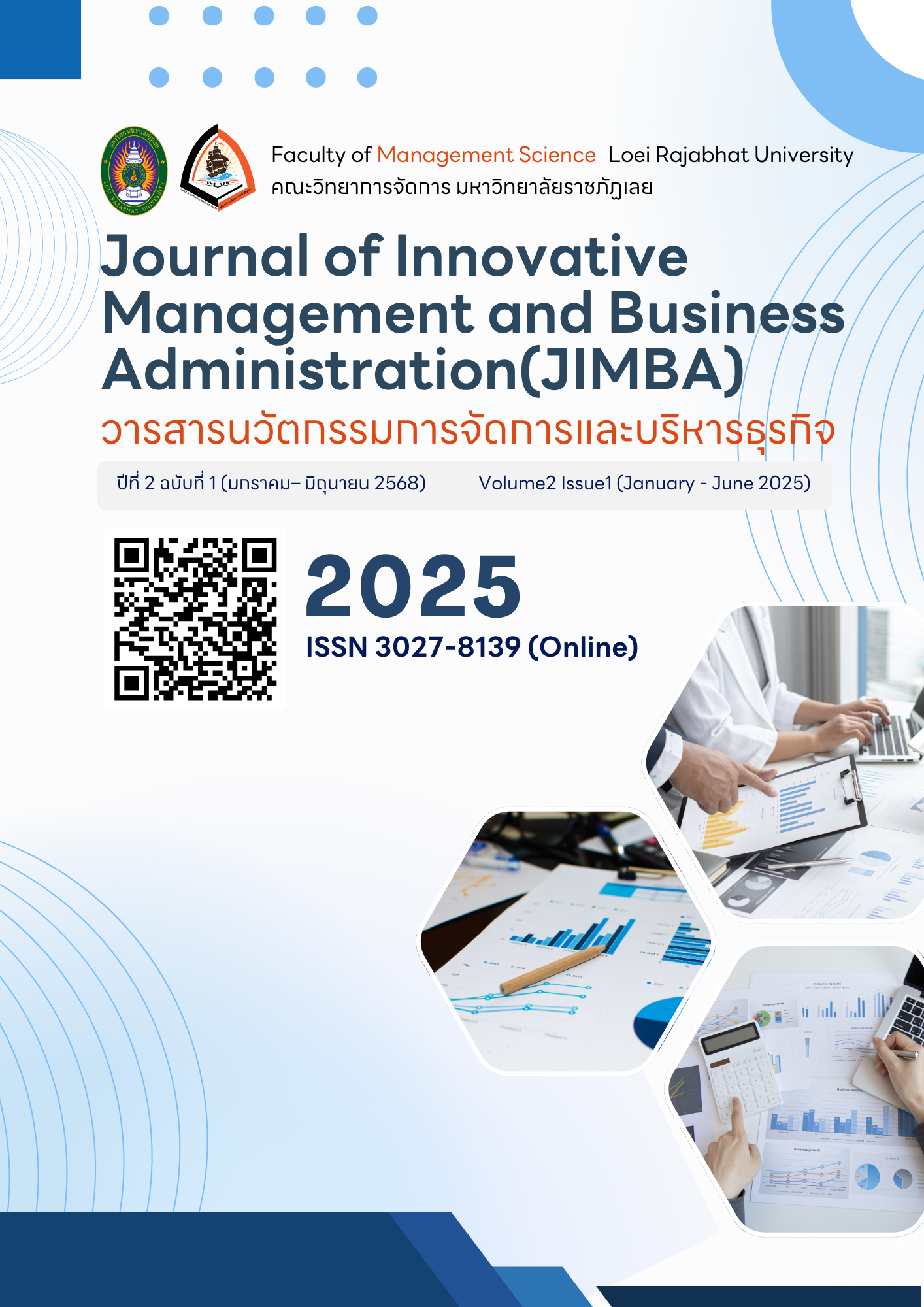The Factors Affecting Brand Awareness of Mr. D.I.Y in Thailand
Main Article Content
Abstract
The purposes of this study were: 1) to study the level of respondents’ opinions on customer engagement, brand attitude, brand exposure, electronic word-of-mouth communication, and brand awareness, 2) to study the influence of customer engagement, brand attitude, and brand exposure on electronic word-of-mouth communication and 3) to study the influence of electronic word-of-mouth communication on brand awareness. The questionnaires were collected between May and June 2024, and the research follows a quantitative research was conducted using primary data. The sample consisted of 400 customers of Mr. D.I.Y. who had experience in purchasing products and using services from the store. They were selected by purposive sampling and convenience sampling. Data were collected using a questionnaire. Data were analyzed using descriptive statistics, including frequency distribution, percentage, standard deviation, and Pearson correlation coefficient, and regression analysis.
The results of the research found that: 1) The respondents' opinions regarding customer engagement, brand attitude, brand acceptance, electronic word-of-mouth communication, and brand awareness were all at a high level. 2) Hypothesis testing revealed that customer engagement, brand attitude, and brand acceptance had a positive and statistically significant influence on electronic word-of-mouth communication at the .01 level. 3) Electronic word-of-mouth communication had a positive and statistically significant influence on brand awareness at the .01 level.
Article Details

This work is licensed under a Creative Commons Attribution-NonCommercial-NoDerivatives 4.0 International License.
บทความนี้ได้รับการตีพิมพ์เป็นลิขสิทธิ์ของมหาวิทยาลัยราชภัฏเลย
เนื้อหาและข้อมูลในบทความที่ตีพิมพ์ใน วารสารนวัตกรรมการจัดการและบริหารธุรกิจ มหาวิทยาลัยราชภัฏเลย ถือเป็นความคิดเห็นและความรับผิดชอบของผู้เขียนบทความโดยตรง กองบรรณาธิการวารสารไม่มีส่วนในความคิดเห็นและความรับผิดชอบใดที่เกี่ยวข้องกับบทความดังกล่าว
References
กัณฐิกา จิตติจรุงลาภ. (2562). การสื่อสารแบบปากต่อปากอิเล็กทรอนิกส์ต่อพฤติกรรมการซื้อสินค้าออนไลน์. สำนักพิมพ์มหาวิทยาลัยธรรมศาสตร์.
กิตติพงศ์ อิ่มประคองศิลป์, & นภณัฐ ชมพู. (2564). แนวคิด ทฤษฎีที่เกี่ยวข้องกับการมีส่วนร่วมและความผูกพัน (Engagement). สืบค้น 10 กุมภาพันธ์ 2567, จาก https://dusitpoll.dusit.ac.th/KB/2021/583/
กิตติวัฒน์ คล้ายนิล. (2565). ทัศนคติและพฤติกรรมผู้บริโภคที่ส่งผลต่อความตั้งใจซื้อผลิตภัณฑ์เครื่องสำอางและผลิตภัณฑ์ดูแลผิว กลุ่ม Green beauty ในเขตกรุงเทพมหานครและปริมณฑล (ค้นคว้าอิสระปริญญามหาบัณฑิต). มหาวิทยาลัยมหิดล.
กรชนก บุญสู่ทรัพย์ไพศาล. (2563). การศึกษาการเปิดรับข้อมูลข่าวสาร การตัดสินใจซื้อ และพฤติกรรมเกี่ยวกับเสื้อผ้าแฟชั่นของผู้บริโภคในเขตกรุงเทพมหานคร กรณีศึกษา Hamburger Studio (การค้นคว้าอิสระปริญญามหาบัณฑิต สาขาวิชาการบริหารธุรกิจบันเทิงและการผลิต). มหาวิทยาลัยกรุงเทพ.
กรมการปกครอง กระทรวงมหาดไทย. (2566). ข้อมูลทั่วไปด้านประชากร. สืบค้น 19 มีนาคม 2567, จาก https://www.boi.go.th/
กรมพัฒนาธุรกิจการค้า. (2566). กรมพัฒนาธุรกิจฯ เผย ‘ที่สุดแห่งปี 2566 ด้านการลงทุนในประเทศไทย’ นักลงทุนไทยแห่จัดตั้งธุรกิจใหม่ ทะลุ 8.5 หมื่น. สืบค้น 7 กุมภาพันธ์ 2567, จาก https://www.dbd.go.th/news/09230167
จรัล รัศมิทรัพย์. (2557). อิทธิพลขององค์ประกอบคุณค่าตราสินค้าจากมุมมองของลูกค้าที่ส่งผลต่อความไว้วางใจและตั้งใจเลือกใช้บริการกับ บมจ.ธนาคารกรุงไทย ในเขตกรุงเทพมหานคร และปริมณฑล (ค้นคว้าอิสระปริญญามหาบัณฑิต). มหาวิทยาลัยกรุงเทพ.
ชานันต์ รัตนโชติ. (2552). ประโยชน์ในการรับข่าวสารจากหนังสือพิมพ์ออนไลน์ของประชาชนในกรุงเทพมหานคร (วิทยานิพนธ์ปริญญามหาบัณฑิต). มหาวิทยาลัยรามคำแหง.
ชนม์ชุดา วัฒนากร, & บุฎกา ปัณฑุรอัมพร. (2563). ปัจจัยที่มีผลต่อการตัดสินใจซื้อเครื่องดื่มที่มีส่วนผสมของกัญชา-กัญชงของกลุ่มผู้บริโภคในเขตกรุงเทพมหานคร (สารนิพนธ์ปริญญามหาบัณฑิต).
เซ่าหยี แซ่ฟัง. (2565). การตลาดเชิงสัมพันธ์ เพื่อสร้างความภักดีของลูกค้าในยุคดิจิทัล. วารสารการจัดการและการพัฒนา มหาวิทยาลัยราชภัฏอุบลราชธานี, 12(1), 45-60.
ณัฐกานต์ ทองมวน. (2558). ปัจจัยที่มีอิทธิพลต่อความจงรักภักดีของผู้บริโภคที่ใช้บริการร้าน Coffee café ในกรุงเทพมหานคร ได้แก่ E – Word of Mouth และ ทัศนคติ (การค้นคว้าอิสระปริญญามหาบัณฑิต). มหาวิทยาลัยกรุงเทพ.
ดารณี พานทองพาลุสุข. (2542). ทฤษฎีการจูงใจ. สำนักพิมพ์มหาวิทยาลัยรามคำแหง.
ดวงกมล สุวรรณธีระกิจ. (2558). ศึกษาพฤติกรรมการเปิดรับสื่อ และความพึงพอใจของนิสิตระดับปริญญาตรีภายในสถานศึกษาที่มีต่อชุดสื่อประชาสัมพันธ์ ส านักประชาสัมพันธ์และสารสนเทศศาสตร์ มหาวิทยาลัยราชภัฎบ้านสมเด็จเจ้าพระยา (ครุศาสตร์อุตสาหกรรมมหาบัณฑิต เทคโนโลยีการเรียนรู้และสื่อสารมวลชน). มหาวิทยาลัยเทคโนโลยีพระจอมเกล้าธนบุรี.
ถวิล ธาราโภชน์. (2532). จิตวิทยาสังคม. กรุงเทพฯ: โอเดียนสโตร์.
บุญฐเนตร โถวสกุล, & วสันต์ สกุลกิจกาญจน์. (2562). ทัศนคติการบอกต่อและการรับรู้ตราสินค้าที่มีอิทธิพลต่อความตั้งใจซื้อสินค้าของผู้บริโภคผ่านแอปพลิเคชั่น Shopee ในเขตกรุงเทพมหานคร. สืบค้น 1 มีนาคม 2566, จาก https://ir.swu.ac.th/xmlui/bitstream/handle/123456789/19460/Bas-Con-BoontanetT.pdf?sequence=1&isAllowed=y
บุริม โอทกานนท์. (2554). โอกาสของธนาคารธนชาต. จุฬาลงกรณ์วารสาร, 23, 91.
ปาริษา จันเพ็ชร์. (2565). ทัศนคติของผู้บริโภคต่อตราสินค้าที่มีบรรจุภัณฑ์เพื่อความยั่งยืน ที่ส่งผลต่อความตั้งใจซื้อของผู้บริโภค (ค้นคว้าอิสระปริญญามหาบัณฑิต). มหาวิทยาลัยมหิดล.
ปรีดี นุกุลสมปรารถนา. (2563). บันไดสู่การสร้าง Emotional Brand ขั้นสุด (ออนไลน์). สืบค้น 10 กุมภาพันธ์ 2567, จาก https://www.popticles.com/branding/emotional-brand-ladder/
ประภาเพ็ญ สุวรรณ. (2520). พฤติกรรมศาสตร์และพฤติกรรมทางสุขภาพการศึกษา. กรุงเทพฯ: เจ้าพระยาการพิมพ์.
พิชญา กอกอบลาภ. (2563). ทัศนคติและคุณค่าตราสินค้าที่มีความสัมพันธ์กับการตัดสินใจใช้ไลน์ทีวีของผู้บริโภคในเขตกรุงเทพมหานคร. วารสารบริหารธุรกิจศรีนครินทร์วิโรฒ, 12(2), 75-89.
พภัสสรณ์ แช่มศักดิ์สิทธิ์. (2563). การสื่อสารแบบปากต่อปากอิเล็กทรอนิกส์ ส่วนประสมทางการตลาดในมุมมองผู้บริโภค และคุณค่าตราสินค้าที่ส่งผลต่อการตัดสินใจซื้อคอนโดมิเนียมระดับกลาง บริษัท พร็อพเพอร์ตี้เพอร์เฟค จำกัด (มหาชน) ของผู้บริโภคในเขตกรุงเทพมหานคร. วารสารบริหารธุรกิจศรีนครินทร์วิโรฒ, 12(1), 60-74.
พรกมล รัตนาภรณ์. (2542). รูปแบบการดำเนินชีวิต พฤติกรรมการเปิดรับสื่อและพฤติกรรมการบริโภคสินค้าของวัยรุ่นในจังหวัดเชียงใหม่ (วิทยานิพนธ์ปริญญามหาบัณฑิต). จุฬาลงกรณ์มหาวิทยาลัย.
พรพรรณ พิทยบำรุง. (2562). การศึกษาคุณค่าตราสินค้าที่ส่งผลต่อทัศนคติ และพฤติกรรมการบอกต่อ (Word of Mouth) ของผู้บริโภคในเขตกรุงเทพมหานคร: กรณีศึกษาแบรนด์แอปเปิล (Apple) (สารนิพนธ์ปริญญามหาบัณฑิต). มหาวิทยาลัยมหิดล.
พิลาสลักษณ์ อนันตธนโชคดี. (2560). การรับรู้ของลูกค้าต่อภาพลักษณ์แบรนด์ดรีมมี แวลลีย์ (วิทยานิพนธ์ปริญญามหาบัณฑิต สาขาวิชาการตลาด
Aaker, D. A. (1991). Managing brand equity: Capitalizing on the value of a brand name. New York, NY: The Free Press.
Assael, H. (1998). Consumer behavior and marketing action (6th ed.). Cincinnati, OH: South-Western College Publishing.
Cochran, W. G. (1977). Sampling techniques (3rd ed.). New York, NY: John Wiley & Sons.
Fisher-Buttinger, C., & Chichester, L. (2008). Connective branding: Building brand equity in a demanding world. West Sussex, UK: John Wiley & Sons.
Hollebeek, L. D. (2011). Demystifying customer brand engagement: Exploring the loyalty nexus. Journal of Marketing Management, 27(7-8), 785–807.
Kiecker, P., & Cowles, D. (2002). Interpersonal communication and personal influence on the Internet: A framework for examining online word-of-mouth. Journal of Euromarketing, 11(2), 71–88.
Kietzmann, J., & Canhoto, A. (2013). Bittersweet! Understanding and managing electronic word of mouth. Journal of Public Affairs, 13(2), 146–159.
Klapper, J. T. (1960). The effects of mass communication. New York, NY: Free Press.
Kotler, P., & Keller, K. L. (2009). Marketing management [eBook]. Pearson Higher Ed.
Kudeshia, C., & Kumar, A. (2017). Social eWOM: Does it affect the brand attitude and purchase intention of brands? Management Research Review, 40(3), 310–330.
McCombs, M. E., & Becker, L. B. (1979). Using mass communication theory. Englewood Cliffs, NJ: Prentice Hall.
McEwen, W. J. (2005). Married to the brand: Why consumers bond with some brands for life. New York, NY: Gallup Press.
Mollen, A., & Wilson, H. (2010). Engagement, telepresence and interactivity in online consumer experience: Reconciling scholastic and managerial perspectives. Journal of Business Research, 63(9-10), 919–925. https://doi.org/10.1016/j.jbusres.2009.05.014
Morgan, D. L., & Hunt, S. D. (1970). Determining sample size for research activities. Educational and Psychological Measurement, 30(3), 607–610.
Norman, L. M. (1971). Introduction to psychology. Boston, MA: Houghton Mifflin Company.
Patterson, K. (2006). An integrative definition of leadership. International Journal of Leadership Studies, 1, 6–66.
Pollar, R., & Mittal, B. (1993). Here’s the beef: Factors, determinants, and segments in consumer criticism of advertising. Journal of Marketing, 57(3), 99–114. https://doi.org/10.1177/002224299305700307
Richins, M. L., & Root-Shaffer, T. (1998). The role of evolvement and opinion leadership in consumer word-of-mouth: An implicit model made explicit. Advances in Consumer Research, 15(1), 32–36.
Siew Mung Tan. (2021). จับประเด็น MR. D.I.Y. ทำไมกล้าทุ่มงบ 2,000 ล้านบาท ผุดสาขาใหม่ 195 แห่ง. สืบค้นเมื่อ 10 กุมภาพันธ์ 2567, จาก https://www.marketingoops.com/news/biz-news/mr-d-i-y-invest-new-branches/
Thorson, E., & Rodgers, S. (2006). Relationships between blogs as eWOM and interactivity, perceived interactivity, and parasocial interaction. Journal of Interactive Advertising, 6(2), 5–44. https://doi.org/10.1080/15252019.2006.10722117


